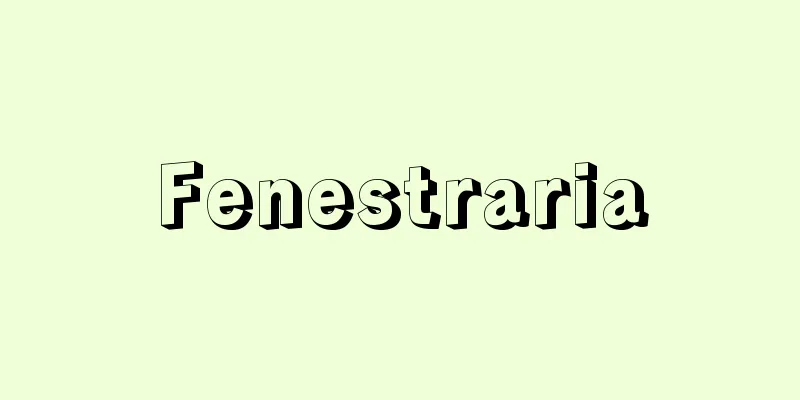Masked play

|
A play in which some or all of the characters wear masks. Masks originally served as a medium for the souls of the dead and the forces of nature, but what sets masks apart from other mediums is that the souls and powers that reside in them are believed to be transferred to the person wearing them. Therefore, when a masked character appears in a play, it often represents the appearance of a being from another world that transcends everyday life, such as a god, evil spirit, the dead, or a spirit of something, and it can be said that the older the form of theater that was not yet differentiated from magic or religious rituals, the more masks were used. However, as long as the actor's attempt to transform into something other than himself and create a world beyond reality through his actions remains at the heart of theater, the spirit has not been lost entirely, even in modern and post-modern theater, where masks have been replaced by makeup and disguise. [Ando Shinya] WesternIn the West, masks were first used in theatrical performances in ancient Greece, which reached its peak in the 5th century BC. It is said that there were earlier performing arts using masks in Egypt and Crete, but these were part of religious ceremonies and festivals, and cannot be considered independent masked dramas. Greek tragedy is said to have begun with a waltz chorus performed by people wearing animal skins and playing the role of satyrs in praise of Dionysus, the god of wine. However, masks that represented gods in the early days came to be used to portray heroes as demigods in the mythological age with the birth of tragedy. These masks, made of painted leather or cloth, essentially magnified the performer's appearance and voice, giving him a superhuman presence, thereby guaranteeing the transcendence of the dramatic universe from reality and the ritual nature of theater. On the other hand, the individualization of the appearance of each mask also made it possible for one actor to play many roles. As time went on, the features of the masks became increasingly exaggerated, and in tragic plays, the aim was to create a stronger impression with expressions distorted by passion and anguish, while in comedies, grotesque and comical clown masks helped to promote the stereotyping of the characters. Ancient Rome inherited this tradition, but as theater forgot its ritual nature and tragedy declined, the tragic masks lost their power, and instead, the Atellana, a folk and satirical comedy that used even more bizarre masks than the Greek-style comic masks, flourished. This tradition was passed down through the costumes of devils in medieval religious dramas and clown masks in carnival processions, and was passed down to the Commedia dell'Arte in Renaissance Italy. In this improvised comedy, most of the main characters, except for a few, such as lovers, wore masks (made of thick leather or thin wood carvings) that covered the whole or upper half of their faces, rather than wearing headgear, and thus always expressed the same role and personality. This masked drama had a great influence throughout Europe, but from the early modern period, when dramas began to depict conflicts and psychological struggles in human society, to the modern era, when realism became the mainstream of art, the tradition was lost, and only a few traces of it remain in the black masks that cover only the eyes, used in court dance dramas and masquerade balls. However, in the 20th century, as expectations grew for theatre to go beyond the mere imitation of everyday life and regain true theatricality, aiming for ritual through the presence of a transcendental world, the importance of masks was rediscovered by many avant-garde theatre artists, from Gordon Craig, Copeau, and O'Neill to Brecht and Genet, and even today excellent contemporary masked plays with new meanings are often performed. [Ando Shinya] OrientalCompared to Western theatre, where masks have been lost, the East is a treasure trove of masked dramas. Oriental masked dramas have a very strong dance-like character, and many of them would be more accurately described as masked dances or masked dance dramas. They are widely and diversely distributed in India, Nepal, Bhutan, Tibet, Mongolia, Sri Lanka, Indonesia, China, the Korean peninsula, Japan, and other places. In terms of form, they can be broadly divided into two types: those that remain in the realm of religious arts associated with myths and legends, and those that have developed or are trying to develop into theatrical performances. The former include the Indian Cho, the Nepalese Mahakali Pyakun, Tibetan jumping dances, Indonesian Topeng and Barong, and the latter include the Sri Lankan Kolam, Korean masked dance drama (Taltum Nori), and Japanese Noh. Of course, there is an organic exchange between the two in terms of form, and both are, in principle, male-centered masked dramas that are off-limits to women. (1) In eastern India, there is a masked dance called "Chhau" in Purulia, Sidnapur, Seraikela and other areas. It is performed in over 500 regions, each with its own unique characteristics. The Chhau in Purulia is often a battle scene between fierce male and female gods, inspired by stories such as the Mahabharata and Devi Mahatmya. The Chhau in Seraikela is said to have originated as a warrior's dance, and is rich in entertainment value, with male and female gods talking about love and dancing gracefully. (2) Nepal There is a mask festival to praise the greatness of the Great Mother Goddess Naba Durga, and one of these is the "Mahakali Pyakun" (dance), which came to Japan in 1981 (Showa 56). It is based on the Indian classic "Devi Mahatmya," and tells the story of the three goddesses Mahakali, Mahalakshmi, and Kumari, who are incarnations of Durga, fighting and defeating the demon brothers. It has been adapted to Nepal by adding the demons Lakhe and Kyak, who appear in Nepalese legends. (3) China Ethnic minorities such as the Mongolians and Manchus dedicated a dancing dance (officially called "attacking ghosts") to the Lama Temple Festival. This is one of the Tibetan Buddhism (Lamaism) religious arts in which demons wearing black and white skull-shaped masks dance wildly to drive away evil spirits. It is held during the Chinese New Year and is popular in Tibet, the home of Tibetan Buddhism. Masked dramas have disappeared among the Han people, but their image is conveyed in the form of makeup in singing dramas such as Peking opera, and lion dances are also popular in various places during the Chinese New Year. (4) Sri Lanka Two masked dances, Dhobir and Kolam, are handed down in Sinhala. Dhobir is a ritual for healing illness, in which dancers appear at the shrine wearing masks of Yaga (evil spirit), the god of disease, and talk to a medium while dancing. Kolam is a comical and satirical masked play in the first half in which castes such as washermen and drummers interact with the ruling class such as kings, officials, and policemen, and in the second half, the performance shifts to the realm of the gods, where good and evil gods and demons appear. (5) Indonesia There are several kinds of topeng (mask/masked drama) mainly in Java, and Barong in Bali. Topeng is derived from wayang topeng, which is based on an old story called "Panji." Prince Panji's bride, Chongdro Kirono, is kidnapped by a demon on the eve of their wedding, and after some wandering, he rescues her. Many kinds of topeng have been created based on this original story, and the currently well-known Krono Topeng. In Bali, there is a masked dance of Barong Hekija Shinkei, a demon who is likened to a lion. (6) Korea Various masked dance dramas (daltsumunori) are performed in the central and western parts of the country, such as the Sandaenori style in the southern Gyeongsang Province, the Okwangdae style in the southern region, and the Byeolshinjae style, a shamanistic ritual, in the eastern part of the country. The story has little religious overtones and is centered on the human world, making it a thrilling drama that sharply satirizes monks, yangban (the ruling class), and decadent common people. It is composed mainly of dance, dialogue, songs, and witty remarks. There is also the Bukcheong Lion Dance. In addition to the above, Bhutanese temples perform masked dramas centered around monks, and Southeast Asian countries such as Cambodia and Thailand perform Khmer masked dances. In addition, masked folk dances also exist in Africa and Oceania, which have an abundance of masks, but they are intertwined with religious rituals and other such activities, and research into them has not yet progressed. In Japan, there is Nohgaku, a traditional performing art that is the culmination of earlier performing arts such as Gigaku (now extinct, with only the masks remaining), Bugaku (traditional dance), Sangaku (traditional dance), and Dengaku (traditional dance). Noh stands out among the world's masked theatre, as it is highly symbolic, with only the shite actor wearing a Noh mask. In addition, many other folk performing arts that use masks, such as Kagura, are handed down throughout the country. [Kim Ryoki] "The Changing Gods - Asian Masks" edited by the Japan Foundation (1981, Japan Broadcasting Publishing Association)" ▽ "Thoughts on Masks" edited by Shoji Yamashiro (1982, Libroport) Source: Shogakukan Encyclopedia Nipponica About Encyclopedia Nipponica Information | Legend |
|
登場人物の全員、あるいは一部が仮面をつけて演じる劇。仮面は本来、死者の霊魂や自然界の諸力の依代(よりしろ)としての役割をもっていたが、そこに宿った魂や力がそれをかぶる人間にのりうつるとされるところに他の依代にない仮面の特徴がある。したがって、劇に仮面をつけた人物が登場するとき、それは神、悪霊、死者、事物の精など日常生活を超えた他の世界の存在の出現を表すことが多く、呪術(じゅじゅつ)や宗教儀式と未分化であった古い形の演劇ほど仮面を使用したといえる。しかし、俳優が自己でないものに変身し、その行動によって現実を超えた世界を創造しようとする営みが演劇の根底にある限り、仮面がメーキャップや変装にとってかわられる近世以降の演劇にも、その精神がまったく失われたわけではない。 [安堂信也] 西洋西洋では、紀元前5世紀を頂点とする古代ギリシア劇で初めて仮面が演劇に用いられた。それ以前にエジプトやクレタ島においても仮面を使用した芸能があったともいわれるが、それらは宗教儀式や祭礼の一部であって、独立した仮面劇とは認めがたい。ギリシア悲劇は、獣の皮をまとってサティロスを演じた人々が酒神ディオニソスをたたえるために行った円舞合唱に始まったとされるが、その初期に神を表した仮面は、悲劇の誕生とともに神話時代の半神としてのヒーローたちを演じるのにも用いられるようになった。革や布に彩色を施した被(かぶ)り物のそれらの仮面は、本質的には演ずる者の姿や声を拡大して超人的な存在感を与え、それによって劇的宇宙の現実からの超越性と演劇の祭儀性を保証するものであったが、他方、それぞれの仮面の容貌(ようぼう)の個性化によって、1人の俳優が多くの役を兼ねることも可能にした。時代が下ると仮面の特徴はしだいに誇張され、悲劇面では激情と苦悩にゆがんだ表情により強烈な印象を与えることが目ざされ、喜劇ではグロテスクで滑稽(こっけい)な道化面が役柄の典型化を進めるのに役だった。古代ローマもそれを受け継いだが、演劇が祭儀性を忘れ悲劇が衰退するとともに、悲劇面は力を失い、それにかわって、ギリシア風の喜劇面よりさらに怪奇な仮面を用いる、土俗的で風刺を主とする笑劇アテルラナが隆盛した。 その伝統は、中世宗教劇に登場する悪魔たちの扮装(ふんそう)や謝肉祭行列の道化面を経て、ルネサンス期イタリアのコメディア・デラルテに受け継がれる。この即興喜劇では、恋人役の男女など一部を除いて、おもな登場人物のほとんどが、かぶるのではなく顔全体あるいは上半分を覆う仮面(厚手の革製か薄い木彫り)をつけ、それによってつねに変わらぬ役柄とその性格を表した。この仮面劇はヨーロッパ全土に大きな影響を与えたが、演劇が主として人間社会の相克や心理的葛藤(かっとう)を描くようになる近世から、リアリズムが芸術の主流となる近代に至って、その伝統も失われ、わずかに宮廷舞踊劇や仮装舞踏会に用いられる黒い衣製の目だけを隠すマスクにその名残(なごり)をとどめるのみとなる。しかし、20世紀に入り、演劇が日常性の単なる模写を超えて真の演劇性を回復し、超越的な世界の現前によってその祭儀性を目ざすことが期待されるようになると、ゴードン・クレイグ、コポー、オニールからブレヒトやジュネまで、多くの前衛的演劇人によって仮面の重要性が再認識され、今日もなお新しい意味の優れた現代的仮面劇が上演されることも少なくない。 [安堂信也] 東洋仮面が失われてしまった西洋の演劇に比べ、東洋は仮面劇の宝庫である。東洋の仮面劇はきわめて舞踊的な色彩が強く、仮面舞や仮面舞劇とよぶほうが的確と思われるものが多い。インド、ネパール、ブータン、チベット、モンゴル、スリランカ、インドネシア、中国、朝鮮半島、日本などに広く多様に分布する。形態的にみると、神話伝説にちなんだ神事芸能の域にとどまっているものと、そこから演劇的な発展を遂げたり、遂げようとしているものとの2種に大別できる。前者にはインドのチョウ、ネパールのマハカリ・ピャクン、チベット系の跳舞、インドネシアのトペンやバロンなどを、後者にはスリランカのコーラム、朝鮮の仮面舞劇(タルツムノリ)、日本の能などが含められよう。もちろん両者間には形態的に有機的な交流があり、両者とも原則的には女人禁制の男性中心の仮面劇である。 (1)インド 東部のプルリア、シドナフール、セライケラなどに「チョウ」とよぶ仮面舞踊があり、それを演じる地域は500を超え、地域ごとに特色がある。プルリアのチョウは『マハーバーラタ』『デービー・マーハトミヤ』などの物語から素材を得た荒々しい男女神の戦闘場面が多い。セライケラのチョウは戦士の舞踊に由来するといわれ、それに民族舞踊が加わり、男女の神々が愛を語り、優雅に舞うなど娯楽性が豊かである。 (2)ネパール 大母神ナバ・ドゥルガーの偉大さをたたえる仮面祭があり、1981年(昭和56)に来日した「マハカリ・ピャクン」(舞踊)もその一つ。ドゥルガーの化身であるマハカリ、マハラクシュミ、クマリの3女神が魔神兄弟と戦って勝利を得る内容で、インドの『デービー・マーハトミヤ』の古典に基づく。それにネパール伝説に登場する魔物ラケーやキャクなどが加わりネパール化されている。 (3)中国 少数民族であるモンゴルや満州族などがラマ廟(びょう)祭で跳舞(正称は打鬼)を奉納した。髑髏(どくろ)型の白と黒の仮面をつけた鬼が激しく跳ね踊って邪鬼を追い払うチベット仏教(ラマ教)の神事芸能の一つで、旧正月に行われ、チベット仏教の本拠地であるチベットで盛んである。漢民族においては、仮面劇は絶え、京劇などの唱劇で隈取(くまどり)の形でそのおもかげを伝えており、このほかに各地では旧正月に獅子舞(ししまい)が盛んである。 (4)スリランカ シンハラにドビルとコーラムの二つの仮面舞が伝承されている。ドビルは病気治癒のための神事で、舞い手たちが病神のヤガー(悪霊)の仮面をつけて祭場に現れて踊りながら霊媒者と語り合う。コーラムは、前半では洗濯屋や太鼓打ちなどのカーストたちと王や役人、警官などの支配層が絡み合うコミカルで風刺のきいた仮面劇を演じ、後半では正邪の神々や魔物などが登場する神界に転じる。 (5)インドネシア ジャワ島を中心に数種のトペン(仮面・仮面劇)があり、バリ島にバロンがある。トペンは『パンジ』という古い物語にちなんだワヤン・トペンから派生した。パンジ王子は結婚前夜花嫁のチョンドロ・キロノを魔神にさらわれ、放浪のすえ取り戻す。この原話を基に幾通りものトペンが生まれ、現在はクロノ・トペンが知られている。バリ島には獅子に比定される魔物のバロンの僻邪進慶(へきじゃしんけい)の仮面舞がある。 (6)韓国 中部から西部に山台劇(サンデノリ)系、南部の慶尚道地方に五広大(オクワンデ)系、東部にクッ(巫祭(ふさい))である別神祭(ビョルシンジェ)など多様な仮面舞劇(タルツムノリ)が演じられている。神事的な色彩が薄く、物語は人間界が中心で、僧侶(そうりょ)や両班(ヤンバン)(支配層)、退廃的な庶民などを痛烈に風刺した痛快な劇である。舞踊を中心に台詞(せりふ)、歌、才談(チェダム)(頓智(とんち))などで構成されている。このほかに北青(ブクチョン)獅子舞がある。 以上のほかに、ブータンの寺院では僧侶を中心とする仮面劇、またカンボジアやタイなどの東南アジアにはクメール系の仮面舞がある。 また、豊富な仮面をもつアフリカやオセアニアにも当然仮面の民族舞踊が現存するが、宗教的祭祀(さいし)などと混然一体となっており、それらの研究はまだ進んでいない。 日本においては、大陸から伝来した伎楽(ぎがく)(現在は絶え、面だけが残っている)、舞楽(ぶがく)をはじめ、散楽(さんがく)や田楽(でんがく)などの先行芸能の集約大成された伝統芸能である能楽がある。シテ方にのみ能面をかけさせることで高度な象徴性をもたせた能は、世界の仮面劇のなかで異彩を放っている。ほかにも、神楽(かぐら)をはじめとする多くの仮面を使用する民俗芸能が全国各地に伝承されている。 [金 両 基] 『国際交流基金編『変幻する神々――アジアの仮面』(1981・日本放送出版協会)』▽『山城祥二編『仮面考』(1982・リブロポート)』 出典 小学館 日本大百科全書(ニッポニカ)日本大百科全書(ニッポニカ)について 情報 | 凡例 |
<<: Confessions of a Mask - Confessions of a Mask
Recommend
Schmelzer, JH (English spelling) SchmelzerJH
…1700). At the same time, violin music also becam...
Northwest Airlines [company] - Northwest Airlines, Inc.
An American private airline. Its headquarters are ...
《Okubo Musashi stirrups》
...The story of Choshichiro is included in the Ut...
Wind direction - Fūkou (English spelling)
The direction from which the wind blows. If the wi...
NHK - NHK
The abbreviation for Japan Broadcasting Corporati...
Irtilish Khan - Irtilish Khan
The Turkic people ruled over northern and central...
Khutbah (English spelling)
A sermon given by Muslims at Friday noon prayer or...
Thermal conduction
This is the phenomenon in which heat flows from h...
Siderite (siderite)
A type of iron ore. Its chemical composition is Fe...
Guillaume de Lorris
A 13th-century French poet. Author of the first pa...
Yuriko Miyamoto
Novelist. Maiden name Nakajo, real name Yuri. Bor...
Ākhūndzāde (English spelling)
1812‐78 Azerbaijani literary figure. Born in Sheki...
Uganda National Liberation Front
...The Amin regime's crackdown on domestic di...
Eckener, H.
…In May 1926, he successfully flew across the Nor...
Mir (English spelling)
Also called obshchina. A traditional Russian rural...









